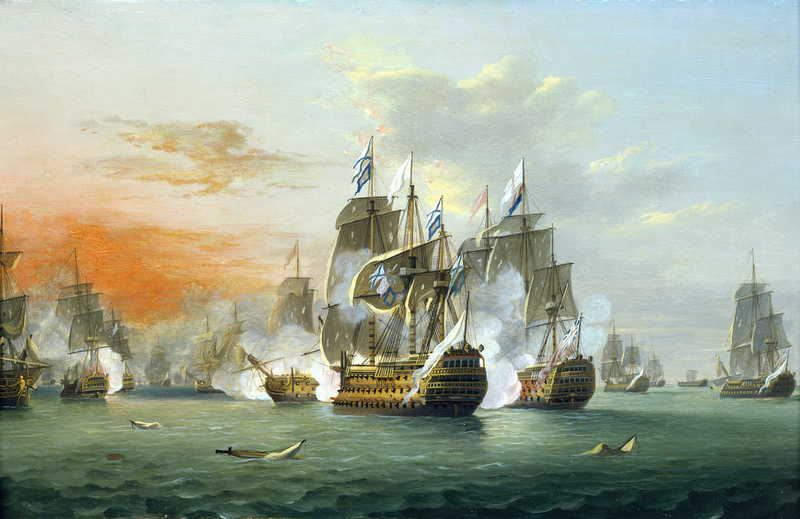
The Battle of The Saints, 12 April 1782 . Thomas Luny
between 1782 and 1837
oil on panel
27.5 × 43.2 cm (10.8 × 17 in)
National Maritime Museum
Accession number BHC0701
Notes
The Saints was the last major action of the American
Revolutionary War, fought near the islets called the Iles des Saintes,
just north of Dominica in the West Indies. Admiral Sir George Rodney's
victory over the French fleet of the Comte de Grasse foiled the
latter's attempt to invade Jamaica and enabled Britain to secure her
position in the West Indies by the treaty that ended the war in 1783,
even though she lost her American colonies. The battle is also famous
as the point of origin of the tactic of 'breaking the line', which was
achieved with great, albeit accidental, effect by Rodney in seizing an
advantage created by a shift of wind as the fleets began the action.
The principal subject here is the clash of flagships of the two
commanders-in-chief, both seen from astern in port- quarter view. The
larger 'Ville de Paris' (110 guns) flagship of de Grasse, is fully seen
in the centre on the left. Admiral Sir George Rodney, in the
'Formidable' (90 guns) is engaging her to starboard on the right,
partly concealed, although de Grasse eventually struck to his
second-in-command, Samuel Hood, in the 'Barham'. Rodney correctly flies
the St George's cross at the main, as an Admiral of the White, but a
red ensign rather than a white one. This was his normal colour but he
had specifically ordered the British fleet to fly red on this occasion,
to minimize confusion in action with enemy ships flying the white
(Bourbon) colours of pre-Revolutionary France, as shown on the 'Ville
de Paris'. There is an inscription identifying the action, written by
Luny in pen and ink on the back of the panel: 'Adml Lord Rodney
Engaging the French Fleet / Commanded by the Count de Grasse April
[12th?] 1782. / T.Luny' .The signature is in the same form as he also
used for painted signatures. The back also bears, stuck down, the
finely engraved trade card of Thomas Merle, who was Luny's London
selling agent from early in his independent career in the 1780s, after
he left the pupilage of Francis Holman. He still had dealings with
Merle until 1817, ten years after permanently moving to Teignmouth.
However, while this picture is undated, the colour and handling suggest
it is relatively early. The rectangular card has the text centred
within a horizontal oval border. At top centre this includes the device
of a hanging key in a smaller vertical oval. It reads: ‘THOMAS [hanging
key] MERLE / (Successor to the late Mr Deerlove) / Picture Frame Maker,
Carver, Gilder & Printseller / At the Golden Key No 36 Leadenhall
Street / London. / Makes & Sells all sorts of Picture Frames,
Carves & Gilds Looking / Glass Frames & Girandoles in the
neatest Taste & at the most / Reasonable Prices. Landscapes &
Sea Pieces neatly Painted. / Pictures carefully cleaned, lined &
mended. / Old Frames new Gilt on the shortest / Notice. / Mouldings of
different Patterns & Lengths for the conveniency of Export.’[1]
ROYAL MUSEUMS GREENWICH
----
Fine Art Prints | Greeting Cards | Phone Cases | Lifestyle | Face Masks | Men's , Women' Apparel | Home Decor | jigsaw puzzles | Notebooks | Tapestries | ...
----


